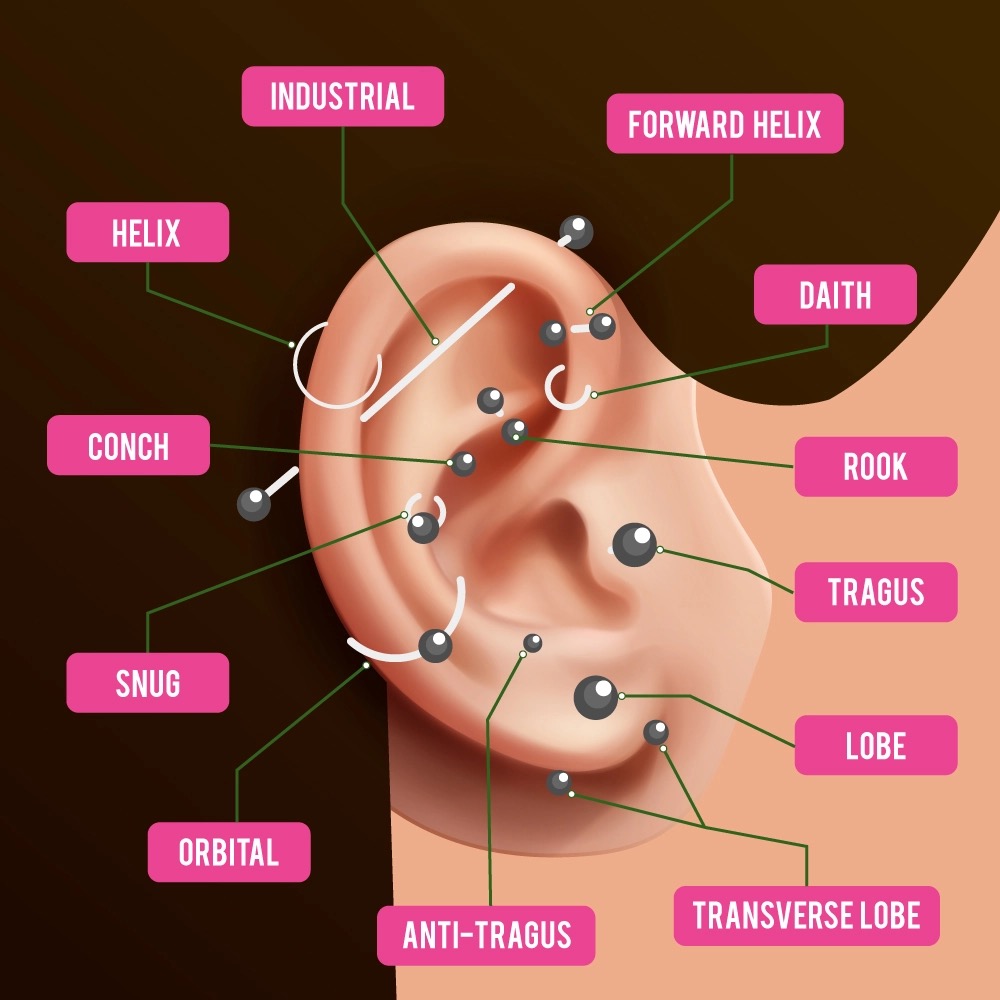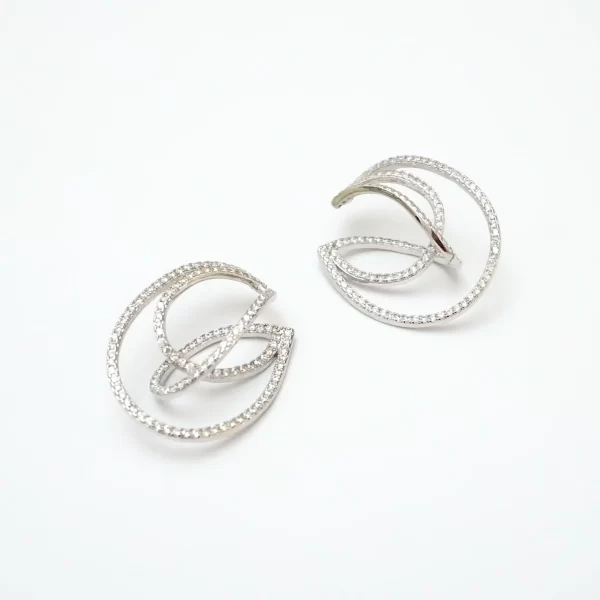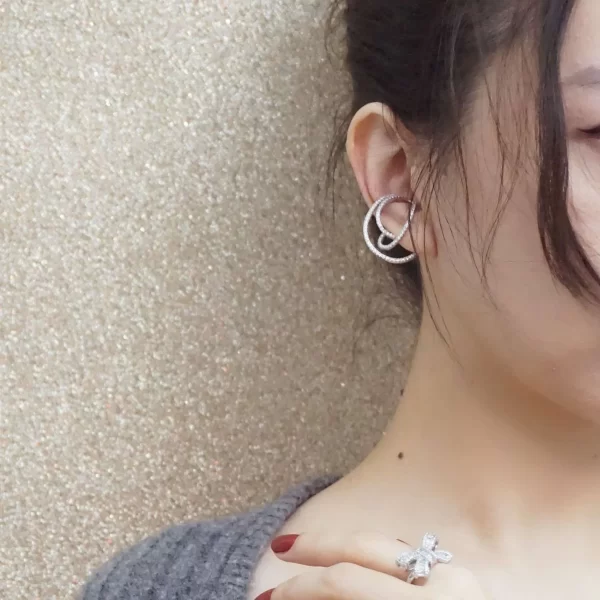Ear Piercings 101: Everything You Need to Know Before Getting Pierced
What is the piercing in your ear called? Which is the most painful ear piercing? Here’s a list of all the types of ear piercings, as well as an ear piercings chart. Let’s get your ear party started!
What are the types of ear piercings?
There are various types of ear piercings to choose from, depending on your preferences and the anatomy of your ear. Some of the most common types of ear piercings are listed below.
Earlobe piercing: This is the most frequent type of ear piercing and includes creating a hole through the soft tissue at the bottom of the earlobe.
Helix piercing: This procedure entails puncturing the cartilage on top of the ear, usually close to the middle.
Tragus piercing: The tragus is a little, elevated piece of cartilage that sits in front of the ear canal. Making a hole through this cartilage is necessary for tragus piercings.
Conch piercing: This piercing affects the ear’s middle cartilage. Conch piercings come in both inner and exterior varieties.
Rook piercing: In the upper portion of the inner ear, there is a fold of cartilage called the rook. This cartilage is punctured during a rook piercing.
Industrial piercing: This procedure includes connecting two holes with a single piece of jewelry. Usually, the front helix receives one piercing and the helix receives another.
Ear piercing chart guide

The pain level of ear piercings
| Name | Pain |
| Lobe Piercing | 3 of 10 |
| Transverse Lobe Piercing | 4 of 10 |
| Snug Piercing | 9 of 10 |
| Rook Piercing | 8 of 10 |
| Industrial Piercing | 8 of 10 |
| Conch Piercing | 6.5 of 10 |
| Tragus Piercing | 4.5 of 10 |
| Daith Piercing | 6.5 of 10 |
| Helix Piercing | 4.5 of 10 |
| Forward Helix Piercing | 6 of 10 |
| Orbital Piercing | 5 of 10 |
| Cartilage Piercing | 7 of 10 |
How long do ear piercings take to heal?
| Name | Healing |
| Lobe Piercing | 4-7 weeks |
| Transverse Lobe Piercing | 5-10 weeks |
| Snug Piercing | 6-12 months |
| Rook Piercing | 3-9 months |
| Industrial Piercing | 3-9 months |
| Conch Piercing | 3-9 months |
| Tragus Piercing | 3-8 months |
| Daith Piercing | 3-6 months |
| Helix Piercing | 3-6 months |
| Forward Helix Piercing | 4-6 months |
| Orbital Piercing | 4-9 months |
| Cartilage Piercing | 4-8 months |
How to clean my ear piercings?
Cleaning your ear piercings on a regular basis is crucial to the healing process and infection prevention. You can take the following actions to clean your ear piercings:
- Before touching your piercings, carefully wash your hands in warm water with soap.
- Use a clean cotton ball or pad to dunk in a saline solution or other post-piercing care product suggested by your piercer.
- Avoid turning or twisting the jewelry as you gently clean the area around the piercing.
- Use a fresh paper towel to pat the piercing area dry or allow it to air dry.
- Avoid applying harsh cleansers, alcohol, or hydrogen peroxide to your piercings since they might irritate the skin and delay healing.
- If your piercer has not directed you to remove the jewelry, do not do so while your piercing is healing.
- To lower the risk of infection, avoid swimming in hot tubs, pools, or natural bodies of water while your wound is healing.
- Follow any special aftercare directions your piercer may have given you.
How to treat my infected ear piercing?
It’s crucial to act quickly if you think your ear piercing may be infected. The following actions can be taken to treat an infected ear piercing:
Clean the area: At least twice a day, wash the affected region with a saline solution.
To prevent further irritability, avoid touching or twisting the earring.
Using a warm compress will help with healing and swelling reduction.
Use of alcohol or hydrogen peroxide should be avoided because they can dry out the skin and slow down the healing process.
Consult a physician: See a doctor if the infection doesn’t go away or gets worse so that you can obtain the right diagnosis and care.
Keep in mind that it is always preferable to avoid infections by carefully caring for your piercings from the start.
Ear cuff for no piercing
If you want to wear earrings but are worried about allergies and pain, ear clips are your best option.
-

 Galaxy Earrings$69.00
Galaxy Earrings$69.00
FAQs
Does piercing inside my ear hurt?
Yes, at least a little. But it’s rare to need anesthesia. Pain levels are subjective and dependent on individual pain tolerance. You can choose lobe piercing, as they’re not only the easiest to wear, but also one of the least painful.
Which is the most painful ear piercing?
In general, a cartilage piercing is more painful than an earlobe piercing. In cartilage perforation, the inner ear piercing is more painful than the outer ear piercing because the inner ear contains tougher cartilage.
Therefore, the most painful ear piercing is the Daisth and Tragus piercing. Snug and rook piercings are also quite painful.
Which ear piercing is the most attractive?
Different types of earrings can be worn with pierced ears. Each earring has its own beauty. You can also mix and match different types of ear piercings to achieve your unique charm.
Which ear piercing is for migraines?
There is no scientific proof that getting your ears pierced will cure or stop migraines. But some people think that getting a daith piercing, which is a piercing through the innermost cartilage fold of the ear, can help relieve migraine symptoms.
If you get migraines and want to get a daith piercing, you should talk to a doctor first and think about the risks and benefits.
Which ear piercing is for anxiety?
Daith Piercing for Anxiety: The daith piercing is thought to be able to help with migraine headaches and anxiety. Although there is no scientific proof to back up these claims, individuals believe that symptoms lessen after obtaining a daith piercing.
Which ear piercing is for weight loss?
Acupressure Point Piercings for Weight Loss: Some acupressure points on the ear are said to help people lose weight. Some people think that getting piercings in these specific places can help to stimulate these pressure points and help with weight loss.
But there is no scientific evidence to back up this claim, and it’s important to remember that if you want to lose weight and keep it off, you need to eat healthily and exercise regularly.
Want to know more about how to care for your newly pierced ears? Read How to Care for Your Newly Pierced Ears.
